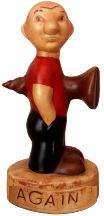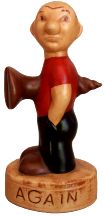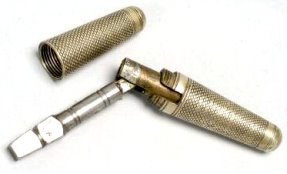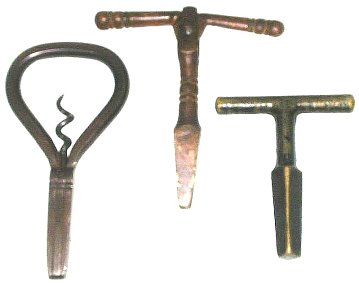 |
 The Virtual Corkscrew Museum's Weekly Newspaper |
 |
 |
 The Virtual Corkscrew Museum's Weekly Newspaper |
 |
|
Sunday, October 21, 2007 |
Number 484 |
Carriage Keys
Carriage key definition: A universal key used for locking and unlocking doors of railway carriages. Additional terms: Railway key; Latch-key
There are a number of combination tools or tool sets which include a corkscrew and a carriage key. The carriage keys can be found on folding bows, picnics, collapsing tools, roundlets, and knives.
In discussing Sheffield cutlers and particularly the firms of Messrs. Rodgers and Messrs. Brookes and Crookes in British Manufacturing Industries (E. Stanford 1876) George Phillips Bevan wrote: "Having heard the expressed desire for a good knife that contained in addition to all the ordinary blades, a railway carriage key, a champagne opener, a corkscrew, a turnscrew, a button hook, and so forth, they have been engaged for weeks in producing such a knife."
This knife has some of the elements suggested in Bevan's work including the carriage key and corkscrew. It was produced by Michael Hunter and Son of Sheffield and is engraved with the initials W. M. and year 1878, two years after the publication of Bevan's book.
Editor's note: Elsewhere in this issue read about the year 1600 corkscrew described by Bevan in his book.
Three folding bows with carriage keys
A folding carriage key with corkscrew and a picnic corkscrew with whistle and carriage key

Roundlet with carriage key
Corkscrew / Carriage Key Roundlet sets (well, almost matching pairs!). The carriage key of the bottom right pair has a whistle.
On February 25, 1891 Carl Hollweg of Barmen, Germany was granted U. S. Patent 447,185 for his collapsing corkscrew. Hollweg noted that the handle of his corkscrew acts as the protecting sheath keeping pockets from ripping. The corkscrew handle is composed of four pieces which are connected at the ends forming a toggle-joint with gears. The screw-shank is secured to the handle at one of the joints. The flats on the handle can be used for advertising purposes. There is no mention in the patent for other uses for his collapsing design, however, above is an example produced with a carriage key.
Can opener with carriage key and corkscrew
So how are these carriage keys used? Bob Roger enlightens us in the story below.
Using Carriage Keys
by Bob Roger
For the privileged, travel during the Victorian era was usually by ship, carriage or rail. Passage ways on the ship and in railroad coaches were tight, and doors to private compartments or staterooms did not have exterior knobs or handles. An exterior door handle on a carriage would get muddy during the trip, and was therefore not used on carriages either. To open a handle-less door latch, the porter would insert his "key" into the square opening left vacant by the missing handle and shaft, turn it to release the bolt or catch, and open the door. A handle might be used on the interior of the door to provide easy exit, or a sliding lever or a 'key' might be used. On carriages there might have been a leather flap or other cover on the outside to keep the mud out of the latch hole.
The latch above is what an interior-mounted latch might look like with no handle and a sliding dead-bolt. These doors were thin, so reaching through the door to an interior latch hole was not a problem for the key.
Two mortise latches that also could have been used

From the collection of Bob Roger
Because the opening to the latch is square, the "key" was usually a very simple tapered square shaft, and it was sometimes combined with another implement needed by the porter, such as a corkscrew. These keys became known as carriage keys. The picture above shows three types. The forged key on the left has been combined with a corkscrew that folds out for use. The key on the right is a single piece brass/alloy key. The key in the center appears to be a bronze or copper alloy and has arms that fold up when not in use.
The bronze or copper alloy key folded up when not in use
Editor's Note: Bob Roger is a collector of corkscrews and a wide variety of tools. He is the author of A Guide to Gimlets published in 2003 and Patented Ice Reducing Tools: An Identification Guide for Hand-Held Picks, Chippers, Crushers, and Shaves published in 2007.
Further Carriage Key Notes
In Iain Ellis' British Railway Engineering Encyclopaedia, we find: "Carriage Key - A simple key used to operate the secondary locks fitted to coach doors and some other access panels on locomotives and rolling stock."
In The Science of Railways (1904) by Marshall Monroe Kirkman under the chapter "Rules Governing Movement of Trains" is "Every passenger guard must have with him his watch, whistle and carriage key, and take in his van a red, a green and a white flag, a box of detonators (not less than twelve), and a hand signal lamp."
This passage appears in The Princess Elopes (Bobbs-Merrill Co. 1905) by Harold MacGrath: "What a brilliant idea it had been to use her private carriage key to steel into the carriage compartment long before the train was made up!"
In addition to the carriage key and knife, this tool has a Prestolite Key* for opening cylinders to turn on gas lamps.
*In the May 8, 2003 issue of The Daily Screw, Bob Roger wrote this story about the Prestolite Key:
Regarding the April 28 issue of The Daily Screwwith the Sommer's powderhorn - If readers are wondering what the square hole in the powderhorn is for, it is a Prestolite key. Prestolite developed a process for filling tanks with acetylene gas (the traditional way was to drip water onto calcium carbide, which produces acetylene gas in real time). The small Prestolite tanks were mounted on bicycles and the running boards of cars (or under the seat), and a copper or brass tube ran to the acetylene lamp(s) on the front.
To light the lamp, the valve on the tank was opened using the "key" (it was a square shank on the valve) by one person, and another person held a match at the lamp, and warned "stand back!" I don't have the start date for Prestolite (I'm thinking circa 1885), but they existed on the cars until circa 1915, then quickly phased out. Sometimes the caplifters had two different sized square holes, so the Prestolite system must have made two different sized tanks/valves. I would suspect that bicycle tanks would be smaller than car tanks.
*In his U. S. Patent No. 1,203,256 of October 31, 1916 for an "Advertising Novelty", Daniel Pettingell combines several useful tools including a corkscrew, a bottle opener, a button hook, a room key, and a "Prestolite Key". He notes "...portion 4 is provided with the rectangular apertures which provide a means for engaging a square shank, as for instance, upon a 'Prestolite' tank."
Bevan's British Manufacturing Industries
In the Carriage Key article we mentioned Bevan's reference to the knives of Brookes and Crookes and Rodgers. It is interesting to note this paragraph as well:
"By whom, when, and where the spring knife was first made, is not certain. Amongst a very interesting collection of old cutlery in the possession of a gentleman at Sheffield is a large single blade spring knife, with the handle of brass-mounted oak, and upon the roughly ground steel blade is a trade mark. It was probably a butler's or sportsman's knife, as at the bottom of the handle and closing into it there is a short corkscrew. No improvement is shown either in the pattern or in the workmanship; its chief characteristic being, that it shuts as a spring"
Now here's the really interesting statement that follows the above:
"It is believed to have been made in Sheffield, about the year 1600, and several eminent antiquaries have pronounced it the oldest know specimen of a spring knife."
|
©2007 Don Bull, Editor |